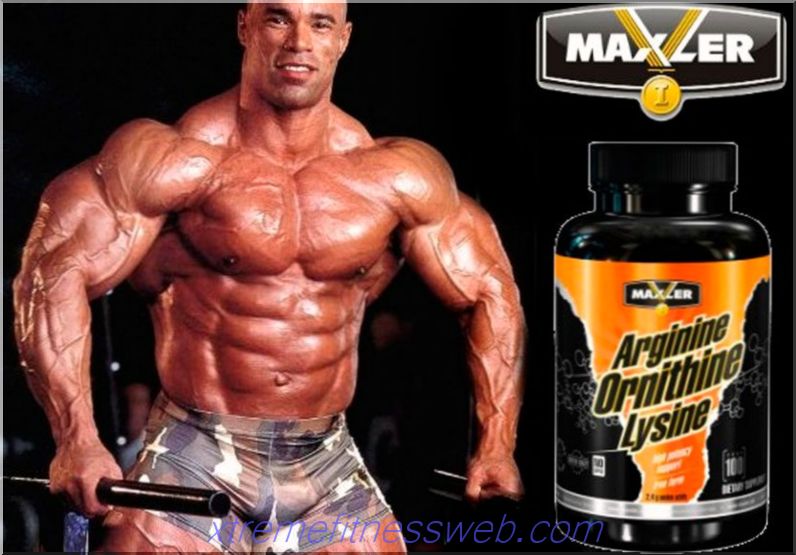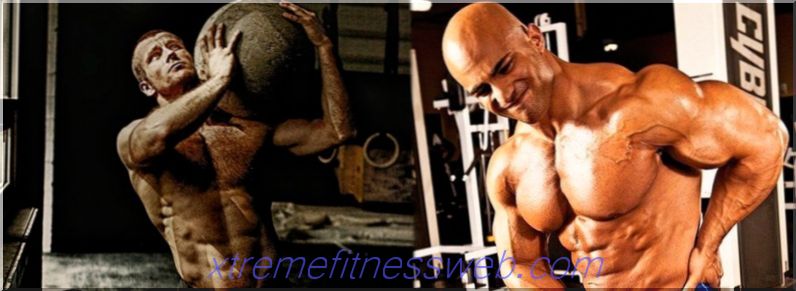- Execution technique
- Recommendations
- Execution Options
- Parsing exercise
- Program Inclusion
- Contraindications

As soon as this exercise is not called - both the bending with the barbell behind the back, and “just the biceps of the thigh combed”, and in different ways. In fact, if you see that the athlete has his back to the Smith bar, and pulls him up, he performs the traction of Lee Haney, and struggles with the lagging back delta. This segment of the deltoid muscle is important for both aesthetics and strength results. For example, a lagging back delta does not achieve impressive bench press results. Its insufficient development does not allow and to take off the shoulders in the deadlock lockout. And not only genetics, but also a lack of understanding of neuromuscular communication interfere with the normal development of the back delta to athletes. Many simply don’t feel it in “big” exercises. Lee Haney’s craving came about as an attempt to solve a problem called “I don’t feel the back delta in the exercises.”
Content
- 1 Technique
- 1.1 Starting position
- 1.2 Movement
- 1.3 Errors
- 2 Recommendations
- 3 Options
- 4 Analysis of exercises
- 4.1 What muscles work
- 4.2 Preparing for the exercise
- 4.3 Correct execution
- 4.4 Errors
- 4.5 Recommendations
- 5 Inclusion in the program
- 6 Contraindications
Execution technique

Starting position
- Set Smith's fingerboard at a height that matches the length of the arms;
- Stand with your back to the simulator, stabilize the lower back by pulling in the stomach;
- Remove the shoulders from the ears, lowering the shoulder blades to the pelvis, and slightly reducing the diamond-shaped;
- Grasp the bar symmetrically with both hands;
- The distance from each palm to the racks should be the same;
- The grip should be made so that the flexion in the elbow joint is comfortable;
- For most people, this grip is 10 cm wider than the shoulders;
- Remove the bar from the safety stops by simply turning it on yourself
Traffic
- When bending your arms at the elbow joints, pull the bar up as far as possible;
- The elbows should be bent;
- In order to ensure sufficient amplitude, raise your shoulders and turn on the trapezoid;
- Buttocks can become an “obstacle” to the neck, so it is allowed to slightly feed the bar back;
- Lowering the neck should be slow;
- The thrust is accomplished due to the rear delta, the trapezoid only helps the movement;
Mistakes
- The thoracic section of the athlete is strongly curved, the back is round;
- The lumbar region either bends too much or is curved, there is no stability in it, the spine changes its angle with each pull;
- Instead of traction, the athlete makes shrugs with a barbell behind his back, that is, raises and lowers weight by lifting his shoulders;
Recommendations
- The spine is stable, it is better not to make movements in the hip joints, removing the buttocks from the trajectory of the neck. It is recommended to perform a slight forward bend so that the movement is more even and smooth;
- It is better to pull Haney’s thrust to the upper part of the lower back, that is, in the maximum depth amplitude, and at the same time control the position of the body so as to avoid helping yourself by changing the angle of inclination of the spine;
- At the extreme point of the amplitude, the elbows should look up, and the angle of flexion in the joint should be sharp;
- To properly perform this craving, you need a good sense of muscle. Ideally, movement begins in the shoulder joint and begins at the expense of the back delta, and the elbows bend afterwards. Those who bend their elbows first, give part of the load to the biceps;
- Work at the expense of the wrists is also not allowed; it is better not to bend them too much, because this shifts the emphasis to the forearms.
Execution Options

There is a separate category of exercises that are most convenient to perform with a fixed barbell, that is, in the Smith simulator. This movement just belongs to this category. Pulling free weight is not convenient, if only because you need a back tilt, and to stabilize the bar you will have to turn on the triceps, which will complicate the exercise and make it less accessible. You can do Haney’s traction in the crossover by attaching a long handle to the lower block, but this option also requires good coordination.
Parsing exercise
Many bodybuilders mistakenly attribute Lee Haney's cravings to isolation exercises. It is not right. In fact, it is a complex traction for the development of the trapezius and deltoid muscles with an emphasis on the posterior delta. It follows that a small shoulder lift in the exercise is not a significant technical error. It is difficult to concentrate on the goal with a significant emphasis on lifting and performing in the style of a shrag.
Sometimes the movement is performed with dumbbells, this allows you to overcome the natural asymmetry of the development of the human body. But in most cases, the movement is performed in the Smith simulator.
What muscles work

For Smith, the following layout of working muscles is advisable:
- Trapezoid and rear deltas as the main movers;
- The muscles that raise the scapula and the rhomboid promote movement;
- Biceps and the entire complex of leg muscles, as well as the press, stabilize the position of the arms and body;
- Exercising with a strong forward bend also uses quadriceps in static
Preparing for the exercise
There are two polar opinions. Some experts believe that the best preparation is a set of pull-ups for reduced amplitude, plus a warm-up of the shoulder girdle of the articular type and an easy stretch. Others believe that a warm-up should include 1-2 sets of bench presses while standing or lying down, since deltas will be a priority load. The second opinion is more justified scientifically, but in the practice of bodybuilding and fitness, both options are found.
Warm-up sets are required in this exercise, beginners should strive to perform them with minimal weight. For most, a light stick, or bodybar, is suitable. Sometimes it is recommended to warm up with dumbbells, although biomechanically this movement will be slightly different.
Correct execution
- The emphasis in moving to work with the shoulders and trapeze, rather than with the elbows and biceps. The start of the movement is from the shoulders;
- The head should not lie on the chest, and the neck should lean forward;
- Natural deflection in the lower back is allowed, but should not be hypertrophied;
- The shoulders are turned on when the elbow has not yet begun to bend, bending the elbow is the second phase of the exercise;
- Hands at the extreme point need to be fully straightened. The movement behind the back implies a short amplitude, and does not contribute to its increase, therefore, it is necessary to consciously increase the amplitude and strengthen the muscle tension due to this;
- Above the elbows should be raised and close to each other, this contributes to the correct distribution of the load and allows you to perform the exercise in the correct mechanics;
- It is important to synchronize movement with breathing. There may be two options - holding the breath on the rise or exhaling on the rise, you need to choose the most convenient;
- The exercise is performed in a sufficiently large number of repetitions, so you need to try not to change the angle of inclination of the spine, and keep the amplitude the same;
- During training, it is not recommended to change the grip, sometimes it turns out that the athlete took the bar is not comfortable, and he has to move his palms, but it is better to avoid this
Mistakes

- Extra bends and humps in the spine;
- "Insertion" of the elbows at the bottom of the exercise;
- Rocking the body and cheating;
- Movement due to a shrug with shoulders;
- Hasty work without delay at the top of the amplitude;
- Disproportionately heavy weights
Recommendations
In grip, work with arms under the shoulders or in a position slightly wider than the shoulders is allowed. Such work allows the athlete to avoid overloading the joint. A narrower grip is not recommended due to the anatomically unnatural position of the shoulders.
Program Inclusion
The inclusion of exercises in the training program is due to its features. This exercise can be considered multi-joint and complex, so its inclusion in the program is due to its nature. The movement turns on after the main bench press on the chest or shoulders, and is compensating for it along the load distribution planes.
The movement is usually performed for 8-12 repetitions, its inclusion in the program in low repetitive mode is not justified. All food, anatomically this is not the most natural movement and it is better to protect the joints by performing it.
Contraindications
Such are any injuries to the shoulder, elbow, and also carpal joints. It is not recommended to perform the exercise for spinal injuries, curvatures, protrusions and hernias. The movement should not be performed if the main goal is progress in the power bench press and the power training cycle. It is best to avoid overloading the rotational cuff of the shoulder, and do it with swings in the slope to the side when performing auxiliary exercises for the back delta.
It is better to include Lee Haney's pull in the training plan no more than once a week, at other times - to perform other exercises for the target muscle group.







